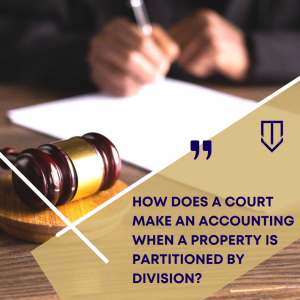 When there is a court-ordered partition by division, there are several steps that both the court and parties take to ensure that the property is physically divided both equally and equitably. Read on to find out the different avenues the court takes when deciding a partition by division lawsuit.
When there is a court-ordered partition by division, there are several steps that both the court and parties take to ensure that the property is physically divided both equally and equitably. Read on to find out the different avenues the court takes when deciding a partition by division lawsuit.
How does the Court Account for partition by Division?
First, the court operates on the assumed guideline that all parties should have the property divided in the most equal and equitable ways possible. The court in the Canepari v. Pascale court case found that there is a rebuttable presumption that the partitioned property should be equally divided. This means that if each co-owner or tenant holds a 50 percent interest in the property, then the property in question is divided as physically possible to a 50/50 divide.
 California Partition Law Blog
California Partition Law Blog

